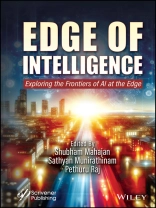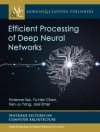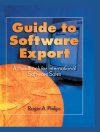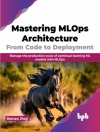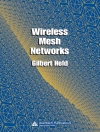The book offers cutting-edge insights and practical applications for Edge AI, making it essential for anyone looking to stay ahead in the rapidly evolving landscape of artificial intelligence and Edge computing.
Edge of Intelligence: Exploring the Frontiers of AI at the Edge examines the transformative potential of edge AI, showcasing how artificial intelligence is being seamlessly integrated with Edge computing to revolutionize various industries. This book offers a comprehensive overview of the latest research, trends, and practical applications of Edge AI, providing readers with valuable insights into how this cutting-edge technology is enhancing efficiency, reducing latency, and enabling real-time decision-making. From optimizing vehicular networks in the era of 6G to the innovative use of AI in crop monitoring and educational technology, this book covers a broad spectrum of topics, making it an essential read for anyone interested in the future of AI and Edge computing.
Featuring contributions from leading experts and researchers, Edge of Intelligence highlights real-world examples and case studies that demonstrate the practical implementation of edge AI in diverse sectors such as smart cities, recruitment, and nano-process optimization. The book also addresses critical issues related to privacy, security, and the fusion of blockchain with edge computing, providing a holistic view of the challenges and opportunities in this rapidly evolving field.
Audience
Engineers, data scientists, IT professionals, researchers, and academics in the fields of artificial intelligence, computer science, and telecommunications, as well as industry professionals in sectors such as the automotive, agriculture, education, and urban planning industries.
表中的内容
Preface xvii
1 A Review on Computational Optimization Strategies and Collaborative Techniques of Vehicular Task Offloading in the Era of Internet of Vehicles and 6G 1
Aishwarya R., V. Vetriselvi and Meignanamoorthi D.
1.1 Introduction 2
1.2 Computational Optimization Strategies 7
1.3 Collaborative Techniques 29
1.4 Security 34
1.5 Challenges and Future Research Directions 39
1.6 Conclusion 41
2 A Study on EDGE AI Application in Crop Monitoring 51
N.A. Natraj, Pethuru Raj, M. Karpagam and S. Gunanandhini
2.1 Introduction 52
2.2 Crop Monitoring AI Basics 57
2.3 AI Applications in Crop Monitoring 60
2.4 Challenges and Possible Future Paths of AI in Crop Monitoring 65
2.5 Conclusion 70
3 A Survey on Reconfigurable Co-Processors Computing Linear Transformations 73
Atri Sanyal and Amitabha Sinha
3.1 Different Linear Transforms 74
3.2 Reconfigurable Computing 75
3.3 Field Programmable Gate Array 78
3.4 Survey of Existing Work 82
3.5 Performance Comparison of Different Reconfigurable Co-Processors Implementing Linear Transformation(s) 86
3.6 Conclusions and Future Work 88
4 Conversational AI Model for Effective Responses with Augmented Retrieval (CAMERA) Based Chatbot on NVIDIA Jetson Nano 93
Kiran Jot Singh, Divneet Singh Kapoor, Amit Singh Bora, Khushal Thakur and Anshul Sharma
4.1 Introduction 94
4.2 Background 100
4.3 Literature Review 103
4.4 Proposed Framework 108
4.5 Results 112
4.6 Conclusion and Future Scope 115
5 Edge Computing in Educational Technology: The Power of Edge AI for Dynamic and Personalized Learning 121
Ganeshayya Shidaganti, V. Aditya Raj, V.R. Monish Raman and Shubeeksh Kumaran
5.1 Introduction: Unveiling the Potential of Edge AI in Educational Technologies 122
5.2 Challenges of Traditional Education in the Digital Age 122
5.3 Edge Computing and AI: Revolutionizing Educational Dynamics 126
5.4.1 Methodology 132
5.5 Benefits of the Edge AI for Learning 139
5.6 Discussions on Edge AI for Education 142
5.7 Ethical Considerations in Edge AI for Educational Settings 144
5.8 Future of Education with Edge AI 147
5.9 Conclusion 149
6 Edge Computing Revolution: Unleashing Artificial Intelligence Potential in the World of Edge Intelligence 153
Saravanan Chandrasekaran, S. Athinarayanan, M. Masthan, Anmol Kakkar, Pranav Bhatnagar and Abdul Samad
6.1 Introduction 154
6.2 Definitions 157
6.3 Concepts and Architecture 160
6.4 Algorithms for Artificial Intelligence in Edge Computing 163
6.5 Optimization of Edge Devices Using a Class of Neural Networks 166
6.6 Bio-Inspired Algorithms for Edge Computing 169
6.7 Real-Time Intelligence-Based Edge Device 172
6.8 Conclusion 182
7 Ensuring Privacy and Security in Machine Learning: A Novel Approach to Efficient Data Removal 193
Velammal B. L. and Aarthy N.
7.1 Introduction 193
7.2 Related Works 195
7.3 Objectives 197
7.4 System Design 198
7.5 Experimental Results 206
7.6 Conclusion and Future Scope 212
8 Federated Learning in Secure Smart City Sensing: Challenges and Opportunities 215
Monika Gandhi, Sushil Kumar Singh, Ravikumar R. N. and Krunal Vaghela
8.1 Introduction 216
8.2 Related Work 218
8.3 Federated Learning-Based Smart Cities Sensing Architecture for Io T-Enabled Smart Cities Sensing 232
8.4 Open Issues, Related Challenges and Opportunities 239
8.5 Conclusions 246
9 Fusion of Blockchain and Edge Computing for Seamless Convergence 253
Indu Bala
9.1 Introduction to Blockchain and Edge Computing 254
9.2 Key Components of Blockchain and Edge Integration 258
9.3 Challenges and Opportunities in Integration 261
9.4 Security Considerations in a Converged Environment 264
9.5 Use Cases and Applications 265
9.6 Benefits of Blockchain and Edge Integration 268
9.7 Regulatory and Compliance Issues 269
9.8 Future Trends and Innovations 271
9.9 Recommendations 274
9.10 Conclusion 276
10 Industry Adapting the Machine Learning Scenario in Recruitment and Selection of Employees 279
Megha Ojha, Vinay Kandpal, Archana Singh and Amar Kumar Mishra
10.1 Introduction 280
10.2 Evolution of Machine Learning in Recruitment 280
10.3 Methodological Insights and Study Contexts 281
10.4 Ensuring Reliability and Replicability 283
10.5 Ethical Implications of ML in Hiring 288
10.6 Addressing Ethical Concerns in Real-World Applications 289
10.7 Ensuring Data Privacy in ML Models for Hiring 289
10.8 Areas for Future Research in ML for Hiring 301
11 Machine Learning for Nano Process Optimization 307
Manjushree Nayak and A. Sai Satya Narayana
11.1 Introduction 308
11.2 Literature Review 309
11.3 Conclusion 323
12 Quantum Computing for Cryptography: An Extensive Survey 327
Soma Debnath and Avishake Adhikary
12.1 Introduction 328
12.2 Related Works 336
12.3 Statistical Analysis 339
12.4 Comparative Analysis 341
12.5 Conclusion and Future Scope 345
13 Role of Blockchain Technology in e-HRM in the Era of Artificial Intelligence: Focus on the Indian Market 351
Archana Singh, Girish Lakhera, Megha Ojha and Amar Kumar Mishra
13.1 Introduction 351
13.2 Literature Review 354
13.3 Blockchains for Business and EHRM 357
13.4 Case Studies 361
13.6 Ethical Implications of Implementing Blockchain in HRM 362
13.7 Conclusion 364
14 Smart City Innovations and Io T as a Frontier of AI at the Edge of Intelligence 369
Priya Soni
14.1 Introduction: Smart City Innovations and Internet of Things for Data Analytics 370
14.2 Concept of Smart Cities and the Significance of Data-Driven Decision-Making 371
14.3 Fundamental Components of Data Analytics in Smart Cities 373
14.4 Advanced-Data Analytics Techniques 375
14.5 Uses of Io T-Enabled Data Analytics in Smart Cities 381
14.6 Challenges and Considerations 382
14.7 Future Prospects and Emerging Trends of Smart City Innovations and Internet of Things (Io T) for Data Analytics 384
14.8 Indian Case Studies: Successful Implementations on Smart City Innovations and Internet of Things for Data Analytics 386
14.9 Conclusion 388
15 Synergies Unleashed: The Convergence of AI and Edge Computing in Transformative Technologies 391
R. Shobarani, P. Dhivya, G. Savitha, S. Santhi, K. Surya Prakhash and R. Kavitha
15.1 Introduction 392
15.2 Related Study 395
15.3 Reduction of Latency 400
15.4 Bandwidth Efficiency 401
15.5 Privacy and Security 402
15.6 Real-Time Decision-Making: Decision Made with an Example 405
15.7 Distributed Architecture: Decentralized Processing Occurs with an Example 407
15.8 Edge Computing Use Cases 410
15.9 Challenges and Advancements 412
15.10 Future Trends 423
15.11 Conclusion 430
References 431
Index 433
关于作者
Shubham Mahajan, Ph D, is an assistant professor at Amity University, Haryana with a remarkable track record in the field of artificial intelligence and image processing. He has published over 77 articles in peer-reviewed journals and conferences, as well as eleven Indian, one Australian, and one German patent. His research includes video compression, image segmentation, fuzzy entropy, nature-inspired computing methods, optimization, data mining, machine learning, robotics, and optical communication.
Sathyan Munirathinam, Ph D, is a senior manager on the Customer Service Data and Diagnostics team for the ASML Corporation with over 24 years of experience in business intelligence and 17 years in the semiconductor industry. His responsibilities involve developing and executing a roadmap for data and diagnostics innovation for customer service engineers, aiming to transition equipment from unscheduled downtime to scheduled maintenance. In addition to this role, he has authored numerous papers and participated in numerous international conferences.
Pethuru Raj, Ph D, is a chief architect in the Edge AI division of Reliance Jio Platforms Ltd., Bangalore. with over 23 years of IT industry and 9 years of research experience. He has been granted two international research fellowships from the Japan Society for the Promotion of Science and the Japan Science and Technology Agency. His research interests include the industrial Internet of Things (IIo T), efficient, explainable, and Edge AI, blockchain, digital twins, cloud-native and edge computing, green and generative AI, and quantum computing.
